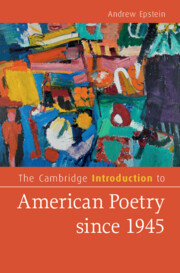Book contents
- The Cambridge Introduction to American Poetry since 1945
- The Cambridge Introduction to American Poetry since 1945
- Copyright page
- Dedication
- Contents
- Acknowledgments
- Introduction
- Part I American Poetry from 1945 to 1970
- Chapter 1 The Raw and the Cooked
- Chapter 2 The Black Mountain Poets
- Chapter 3 The Beats and the San Francisco Renaissance
- Chapter 4 The New York School of Poetry
- Chapter 5 The Middle Generation, Elizabeth Bishop, and Confessional Poetry
- Chapter 6 Deep Image Poetry
- Chapter 7 African American Poetry from 1945 to 1970
- Part II American Poetry from 1970 to 2000
- Part III Into the New Millennium American Poetry from 2000 to the Present
- Works Cited
- Index
- Cambridge Introductions to Literature
Chapter 1 - The Raw and the Cooked
The New Criticism versus the New American Poetry
from Part I - American Poetry from 1945 to 1970
Published online by Cambridge University Press: 01 December 2022
- The Cambridge Introduction to American Poetry since 1945
- The Cambridge Introduction to American Poetry since 1945
- Copyright page
- Dedication
- Contents
- Acknowledgments
- Introduction
- Part I American Poetry from 1945 to 1970
- Chapter 1 The Raw and the Cooked
- Chapter 2 The Black Mountain Poets
- Chapter 3 The Beats and the San Francisco Renaissance
- Chapter 4 The New York School of Poetry
- Chapter 5 The Middle Generation, Elizabeth Bishop, and Confessional Poetry
- Chapter 6 Deep Image Poetry
- Chapter 7 African American Poetry from 1945 to 1970
- Part II American Poetry from 1970 to 2000
- Part III Into the New Millennium American Poetry from 2000 to the Present
- Works Cited
- Index
- Cambridge Introductions to Literature
Summary
This chapter discusses what happens to modernism, the revolutionary movement that dominated the first half of the twentieth century, as it becomes institutionalized, and examines the movement’s legacy after 1945. It discusses how the poetry of the post-1945 period became dominated by a major schism between “academic” and “anti-academic” poetry (or, as Robert Lowell called it, the “cooked” versus the “raw”). The chapter charts the advent of the New Criticism and explains its main principles, goals, and practitioners, focuses on examples of formalist poems in the New Critical mode by Robert Lowell, Richard Wilbur, and James Merrill, and introduces the new, alternative forms of poetry that came to be known as “The New American Poetry.”
Keywords
- Type
- Chapter
- Information
- The Cambridge Introduction to American Poetry since 1945 , pp. 15 - 27Publisher: Cambridge University PressPrint publication year: 2022

